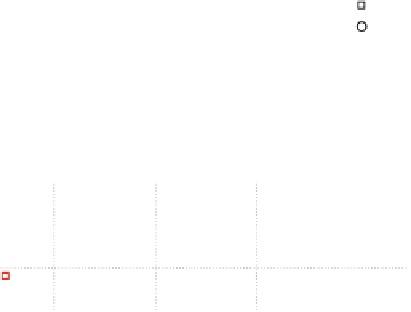Biomedical Engineering Reference
In-Depth Information
a
2.96
E
e
E
e
2.95
2.94
2.93
2
4
6
8
D
(nm)
b
0.19
E
1
h
E
2
h
E
3
h
0.18
0.17
0.16
2
4
6
8
D
(nm)
Fig. 6.8
Same as in Fig.
6.7
but this time for the (
a
) first two bound electron and (
b
)firstthree
bound hole states in the presence of strain but in the absence of the built-in field. [From [
91
]]
6.6.1.2
Influence of Strain on the Electronic Structure
Figure
6.8
shows the calculated single-particle energies of the first two bound
electron and the first three bound hole states in the In
0
.
25
Ga
0
.
75
N/GaN QDM as
a function of the spacer layer thickness
D
, when including in the Hamiltonian the
effects of the strain-induced shifts in the bands, as given earlier by Eq. (
6.8
).
Looking at the electron single-particle energies in the case of large
D
,wefind
that
e
1
e
2
≈
ψ
and
ψ
are again degenerate. For closely spaced QDs (
D
1-2 nm), the
e
2
then form bonding and anti-bonding states, similar to the situation
in the absence of the strain field. The main difference to the results in the previous
section is that
e
1
states
ψ
and
ψ
e
1
e
2
ψ
and
ψ
are shifted to higher energies due to hydrostatic strain in
the system.
The situation is completely different for the hole states. Here, the first two bound
hole states
h
2
do not form bonding and anti-bonding states. When looking
at the probability densities of the hole wave functions (not shown) one finds, that for
closely spaced QDs
h
1
ψ
and
ψ
h
3
are localized on the lower QD. This behavior
is therefore similar to the behavior in a heteronuclear diatomic molecule (e.g., HF),
and occurs primarily due to the following two reasons. Firstly, the strain between
the QDs modifies the valence band offsets, leading to an increased effective barrier
between the dots. Therefore, tunneling and the ability to form bonding and anti-
bonding states is suppressed for the hole states. In addition to this effect, the QDM
lacks a center of inversion. Therefore, the strain state of the upper dot is different
to the strain state of the lower QD. The localization of the hole states on the lower
QD can be understood when looking at the strain field due to an isolated QD. In
an isolated lens-shaped QD, the region at the base of the dot experiences a strong
h
1
,
h
2
ψ
ψ
and
ψ





























































